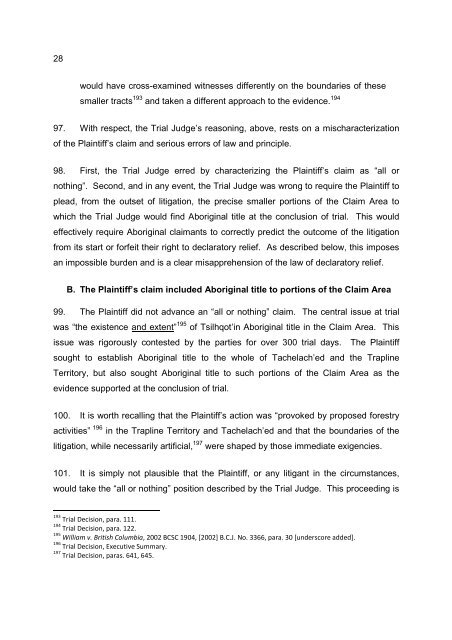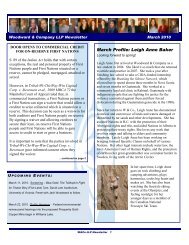28would have cross-examined witnesses differently on the boundaries of thesesmaller tracts 193 and taken a different approach to the evidence. 19497. With respect, the Trial Judge’s reasoning, above, rests on a mischaracterizationof the Plaintiff’s claim and serious errors of law and principle.98. First, the Trial Judge erred by characterizing the Plaintiff’s claim as “all ornothing”. Second, and in any event, the Trial Judge was wrong to require the Plaintiff toplead, from the outset of litigation, the precise smaller portions of the Claim Area towhich the Trial Judge would find Aboriginal title at the conclusion of trial. This wouldeffectively require Aboriginal claimants to correctly predict the outcome of the litigationfrom its start or forfeit their right to declaratory relief. As described below, this imposesan impossible burden and is a clear misapprehension of the law of declaratory relief.B. The Plaintiff’s claim included Aboriginal title to portions of the Claim Area99. The Plaintiff did not advance an “all or nothing” claim. The central issue at trialwas “the existence and extent” 195 of Tsilhqot’in Aboriginal title in the Claim Area. Thisissue was rigorously contested by the parties for over 300 trial days. The Plaintiffsought to establish Aboriginal title to the whole of Tachelach’ed and the TraplineTerritory, but also sought Aboriginal title to such portions of the Claim Area as theevidence supported at the conclusion of trial.100. It is worth recalling that the Plaintiff’s action was “provoked by proposed forestryactivities” 196 in the Trapline Territory and Tachelach’ed and that the boundaries of thelitigation, while necessarily artificial, 197 were shaped by those immediate exigencies.101. It is simply not plausible that the Plaintiff, or any litigant in the circumstances,would take the “all or nothing” position described by the Trial Judge. This proceeding is193 Trial Decision, para. 111.194 Trial Decision, para. 122.195 William v. British Columbia, 2002 BCSC 1904, [2002] B.C.J. No. 3366, para. 30 [underscore added].196 Trial Decision, Executive Summary.197 Trial Decision, paras. 641, 645.
29widely recognized as a publicly important test-case on the nature and extent ofAboriginal title. 198 The consequences for the Xeni Gwet’in and the Tsilhqot’in peopleare profound. No advantage could be gained by the Plaintiff insisting that he wouldrather have the Aboriginal title claims of the Tsilhqot’in people rejected outright thanaccept declarations of Aboriginal title to anything less than the entire Claim Area.102. For his part, the Plaintiff never described his claim as “all or nothing”, nor did heindicate at any point that he was adverse to findings of Aboriginal title to portions of theClaim Area. In fact, it was the Defendants that described the Plaintiff’s claim as “all ornothing”, in a motion brought in the final days of trial, after several years rigorouslylitigating the extent of Tsilhqot’in use, occupation and control of every part of the ClaimArea.103. With respect, the Trial Judge placed undue emphasis on a narrow and untenableinterpretation of the Plaintiff’s pleadings. In his Amended Statement of Claim, thePlaintiff asserted exclusive Tsilhqot’in occupation of the Brittany (Tachelach’ed) and theTrapline Territory 199 and sought the following relief:a) A declaration that the Tsilhqot’in have existing Aboriginal title to the Brittany;b) A declaration that the Tsilhqot’in have existing Aboriginal title to the TraplineTerritory.…n) Such further, other, equitable, and related relief, and such costs, as to thisHonourable Court may seem meet and just. 200104. The Plaintiff did not “explicitly” 201 claim Aboriginal title to portions of Tachelach’edor the Trapline Territory but such lesser included relief is clearly implicit in the198 See e.g.: William v. Riverside Forest Products Ltd., 2001 BCSC 1641, 95 B.C.L.R. (3d) 371; Xeni Gwet'in FirstNations v. British Columbia, 2002 BCCA 434, 3 B.C.L.R. (4 th ) 231, para. 128; Xeni Gwet’in First Nations v. BritishColumbia, 2004 BCSC 610, 240 D.L.R. (4 th ) 547, para. 49; William v. British Columbia (HMTQ), 2009 BCCA 83, [2009]B.C.J. No. 338, para. 6.199 Amended Statement of Claim, paras. 10-11; Trial Decision, paras. 117-18.200 Amended Statement of Claim, Prayer for Relief [underscore added]; Trial Decision, para. 119.201 Trial Decision, para. 120.
- Page 1 and 2: JUN 04 * u|UCOURT OF APPEALCourt of
- Page 3 and 4: C. Alternative Argument: The Trial
- Page 5 and 6: DateDecember 18,1998October 14,1999
- Page 7 and 8: OPENING STATEMENT1. The Tsilhqot’
- Page 10 and 11: 2then Chief of the Xeni Gwet’in,
- Page 12 and 13: 414. The Tsilhqot’in people inhab
- Page 14 and 15: 6… [T]he proper rights holder, wh
- Page 16 and 17: 8F. Tsilhqot’in Territory and the
- Page 18 and 19: 10bounding the Claim Area. For them
- Page 20 and 21: 12…I am satisfied Tsilhqot’in p
- Page 22 and 23: 1452. The Trial Judge summarized th
- Page 24 and 25: 16records document numerous situati
- Page 26 and 27: 18days, Tsilhqot’in warriors also
- Page 28 and 29: 20declaration because of the manner
- Page 30 and 31: 22• On the west, from Xeni across
- Page 32 and 33: 24part of their oral traditions, pr
- Page 34 and 35: 26declaration of title in accordanc
- Page 38 and 39: 30circumstances of the case, which
- Page 40 and 41: 32111. In a subsequent motion, the
- Page 42 and 43: 34by the evidence, then the Court c
- Page 44 and 45: 36exactly what declaration he seeks
- Page 46 and 47: 38declaration should be granted”.
- Page 48 and 49: 40occupation sufficient to ground t
- Page 50 and 51: 42(a) The Plaintiff was not require
- Page 52 and 53: 44process and the legal requirement
- Page 54 and 55: 46157. Proof of an ancestral and mo
- Page 56 and 57: 48uncertainty”. 272 The meaning o
- Page 58 and 59: 50therefore, of opinion, that all n
- Page 60 and 61: 52land regularly used by the Tsilhq
- Page 62 and 63: 54stated that it depends on the fac
- Page 64 and 65: 56the lands in question. At common
- Page 66 and 67: 58193. Moreover, the Trial Judge’
- Page 68 and 69: 60PART 4 - NATURE OF THE ORDER SOUG
- Page 70 and 71: 62R. v. Marshall; R. v. Bernard, [2



